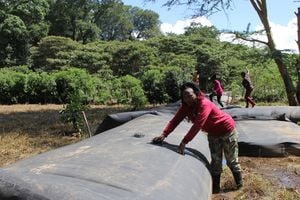Hope for farmers in war on armyworms

Caroline Adongo on her maize farm in Kisumu that has been attacked by fall armyworms.
A new technology that disrupts mating in fall armyworms to suppress populations promises to be a game-changer in the fight against the ravenous pest.
The technology named Pherogen is pheromone-based, with the chemical used mimicking the scent that female armyworms release to attract males for mating.
“The pheromone saturates the farm and forms a cloud in the maize field that confuses the males. They thus loiter in the field trying to work out where the pheromones are coming from, throwing them off the females who are left to lay infertile eggs incapable of hatching into young ones,” said Samuel Muchemi, the field director at Provivi, a US-based firm that developed the trap.
Muchemi said studies done in Kenya since 2019 have shown that the technique is highly successful.
“Application at the beginning of the crop provides season-long control by disrupting the pest's mating and preventing damaging populations' build-up.”
The pheromone sachets are installed using a stick on the farm at a spacing of 20 by 20 metres. At least eight sachets are adequate for an acre. It costs between $24 (Sh2,845) and $35 (Sh4,148) per acre to use the technology.
Fall armyworm
“The pheromone is active for 90 days and should be installed before the emergence of the first shoots of the plant and left there until harvesting,” according to Muchemi.
Muo Kasina, a principal investigator for the fall armyworm and other maize pests at Kenya Agriculture and Livestock Research Organisation (Kalro), says they are seeking a scenario where all farmers in Kenya will be able to use the biological control method as their primary intervention and only integrate chemical pesticides as a secondary measure if the infestation is getting out of control.
“Management of the pest has been challenging because of its rapid proliferation. It can cause up to 100 per cent yield loss if left uncontrolled because the insect lays very many eggs ensuring that within a month it has multiple of generations,” said Kasina during a farm visit at Kalro’s farm in Kinanie, Mavoko, where the trial on the technology is being done. According to him, some farmers have given up on growing maize due to the costs involved in its management.
“We’re seeking a solution to reduce the cost of management and reduce overuse of chemical insecticides as it’s not sustainable.”
Metabolising insecticides
Kasina said maize is not very good at metabolising insecticides, thus requires a big pre-harvest interval, which many farmers don’t observe. “With the love for green maize, the interval may not be enough between the last spray and the roasted maize on our streets. And we’ve to be worried of what this increased use of pesticides on our food systems more so our staple food, is doing to human health.”
Kasina said most farmers discover their crops are attacked by armyworms when the pests are at the caterpillar stage which is the most dangerous. “Farmers need to start managing this insect intelligently, by scouting their maize farms intensively to catch it at the early stages of egg or tiny caterpillar after hatching.”
Cosmas Nzioka, a farmer in Machakos, said one has to spray their farms nine times from establishment to harvest said to curb fall armyworm attack.
“This made me stop planting maize. I’m tired of spraying the crop every week.” Since its discovery in Kenya in 2017, the pest has become a major challenge to maize farmers, causing losses of about a third of the annual maize production— about a million tonnes, according to the Ministry of Agriculture.
The new technology has been adopted in Mexico, Brazil and Asia. In Kenya the product got approval from the Pest Control Products Board (PCPB) last year and will be commercialised by next year.




